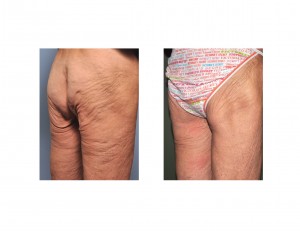Background: There are numerous features of a shapely buttocks. Short of a nipple-areolar complex, the buttocks share many of the same physical components of the female breast. Ideally it is an identifiable mound that projects outward away from the lower back and upper posterior thigh. While the upper pole is a smooth sloping transition from the back, the lower pole of the buttocks should have a more defined separation of the thigh known as the infragluteal crease.
Like the lower breast fold or inframammary crease, the infragluteal fold is a defined attachment of the skin to the underlying gluteal muscle.. It helps create the lower buttock shape and separates it from the back of the leg. It’s presence is caused by fibrous attachments of the dermis of the skin to the muscle fascia. Any disruption of the infragluteal crease results in a saggy buttocks or buttock ptosis.
Buttock ptosis occurs from either loss of a well-defined infragluteal crease or loose buttock tissue falling over a well-defined infragluteal crease. (often called a banana peel deformity) Both aesthetic buttock conditions are treated by a buttock lift, which is more accurately called a buttock tuck. By removing skin and fat from the lower buttocks, any tissue overhang can help reshape an existing infragluteal crease. In a non-existant or lost infragluteal crease, an elliptical excision of loose tissue can help recreate a more discernible infragluteal line.
Case Study: This 49 year-old female wanted to improve her saggy buttocks. She was an ultra-thin middle-aged female that had little subcutaneous fat throughout her body. Her buttocks were completely flat with little volume and folds of hanging skin over the lower buttocks and the upper posterior thigh. There was no discernible infraguteal crease. It appeared that her loss of buttock volume was just part of aging of an historically very thin person.


A buttock tuck (lower buttock lift) is a very effective surgery for remaking the infraguteal fold and creating a buttock-thigh demarcation. It has little after surgery discomfort but does not require avoiding stretching (no exercise) across the suture line for 3 to 4 weeks after surgery The resultant scar heals well and, when well placed, is barely detectable.
Case Highlights:
1) A shapely buttocks, regardless of its size, has an infragluteal crease that separates the buttocks from the posterior thigh.
2) Loose skin from loss of buttock volume creates skin folds that obscures the infragluteal fold.
3) A lower buttock lift, better defined as a buttock tuck, removes loose skin and creates an infragluteal line.
Dr. Barry Eppley
Indianapolis, Indian


